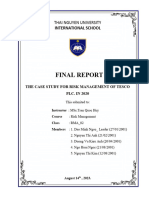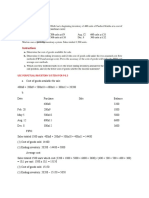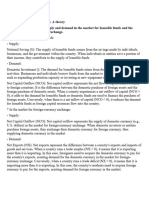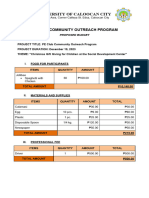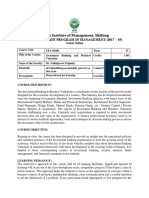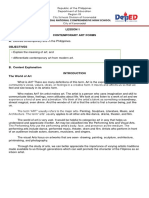Homework 5: Financial System
1. What is a share of stock? What is a bond? Explain their differences and similarities.
- A share of stock is a claim to partial ownership in a firm.
- A bond is a certificate of indebtedness.
- Similarities:
+ Stocks and bonds are both financial instruments used by companies and the government to raise
funds and finance their activities.
+ Stocks and bonds can be bought and sold in financial markets and can be traded among
shareholders.
+ Shareholders can gain the benefits of profits from both stocks (dividends) and bonds (interest
payments).
- Differences:
Stock Bond
The sale of stock to raise money is called The sale of bonds to raise money is called debt
equity finance. finance.
The owner of shares of stock is a part owner of The owner of a bond is a creditor of a
a company. company.
If the company is very profitable, the If the company is very profitable, the
stockholders enjoy the benefits of these profits bondholders get only the interest on their
(dividends). bonds (interest payments).
If the company runs into financial difficulty, If the company runs into financial difficulty,
stockholders are the final to receive any the bondholders are prioritized to be paid what
remaining value. they are due.
Stocks offer the holder both higher risk and Bonds offer the holder both lower risk and
potentially higher return. potentially lower return.
2. Define private saving, public saving, national saving, and investment. How are they
related?
- Private saving is the amount of income that households have left after paying their taxes and
paying for their consumption. It is calculated as Y – T – C, where Y is income, T is taxes and C is
consumption.
�- Public saving is the amount of tax revenue that the government has left after paying for its
spending. It is calculated as T – G, where T is taxes and G is government purchases. If T > G, the
government runs a budget surplus as it receives more money than it spends. This surplus of T – G
represents public saving. If T < G, the government runs a budget deficit as it spends more than it
receives in tax revenue. This causes public saving T - G to be a negative number.
- National saving (S) is the total income in the economy that remains after paying for consumption
and government purchases. It is calculated as S = Y – C – G, where S represents national saving,
Y is income, C is consumption, and G is government spending; or S = (Y – T – C) + (T – G),
where (Y – T – C) is private saving and (T + G) is public saving.
- Investment (I) is equal to national saving (S), which is the total income in the economy that
remains after paying for consumption and government purchases, and thus, investment (I)
represents the total amount of funds available for investment in the economy. It also refers to the
purchase of new capital, such as equipment or buildings, and is calculated as I = Y – C – G, where
I represents investment, Y is income, C is consumption, and G is government spending.
- The relationship between these variables is shown in the equation S = I, which states that saving
(S) must be equal to investment (I) for the economy as a whole. This equation suggests that the
financial system, including the bond market, the stock market, banks, mutual funds, and other
financial markets and intermediaries, plays a crucial role in taking in the nation’s saving and
directing it to the nation’s investment.
3. If more Americans adopted a “live for today” approach to life, how would this affect
saving, investment, and the interest rate?
S=I=Y–C–G
(S refers to national saving, I refers to investment, Y is GDP, C is consumption and G is
government spending)
- Saving: A "live for today" approach involves prioritizing immediate consumption (C) over long-
term savings. If more Americans adopted this approach, the consumption (C) would increase
considerably, causing the national saving (S) to decrease in the economy, as shown in the
equation. People would be more likely to spend their income on current consumption (C) rather
than saving (S) for the future.
- Investment: Investment is an important driver of economic growth, as it funds the creation of
new businesses, infrastructure, and technological advancements. The reduction in saving (S) could
have several consequences, including a decrease in the funds available for investment, which
could potentially slow down economic growth in the long run.
�- Interest Rate: The interest rate reflects the return to saving and the cost of borrowing, and is
determined by the interaction of supply and demand in the loanable funds market. When saving
(S)x decreases due to a "live for today" approach, the supply of loanable funds decreases. At the
same time, the demand for loanable funds would remain the same, as businesses and individuals
may still seek to borrow for investment or consumption purposes. The decrease in the supply of
loanable funds would lead to an increase on interest rates. Higher interest rates would make
borrowing more expensive, potentially discouraging investment and consumption.
4. What is a government budget deficit? How does it affect interest rates, investment, and
economic growth?
- A government budget deficit is an excess of government spending over tax revenue.
- The effect of a government budget deficit can be analyzed using the market for loanable funds:
+ Investment: When the government runs a budget deficit, it reduces public saving, which is part
of national saving (S). This means that investment falls. In other words, when the government
borrows to finance its budget deficit, it reduces the supply of loanable funds available to finance
investment by households and firms. Meanwhile, the budget deficit does not influence the amount
that households and firms want to borrow to finance investment at any given interest rate, thus, it
does not alter the demand for loanable funds. As a result, the supply curve for loanable funds shifts
to the left.
+ Interest rate: The decrease in the supply of loanable funds due to the budget deficit leads to an
increase in the interest rate. Higher interest rates discourage many demanders of loanable funds
from seeking loans to finance investment projects. The fall in investment because of government
borrowing is known as crowding out, as government borrowing competes with private borrowers
for the available funds. Consequently, investment by households and firms decreases, which can
have a negative impact on long-term economic growth.
+ Economic growth: The reduction in investment resulting from a government budget deficit can
hinder capital accumulation and technological progress, both of which are important for long-run
economic growth. Therefore, budget deficits are generally considered to reduce the economy’s
growth rate.


















